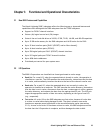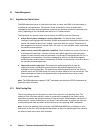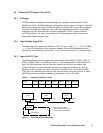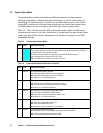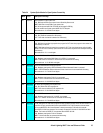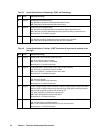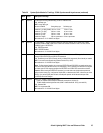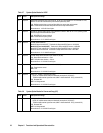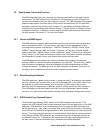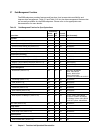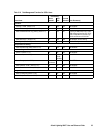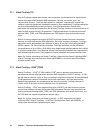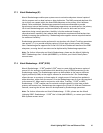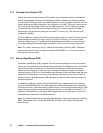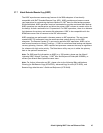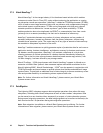Hitachi Lightning 9900™ User and Reference Guide 37
3.6 Open Systems Features and Functions
The 9900 subsystem offers many features and functions specifically for the open-systems
environment. The 9900 supports multi-initiator I/O configurations in which multiple host
systems are attached to the same fibre-channel interface. The 9900 subsystem also supports
important open-system functions such as fibre-channel arbitrated-loop (FC-AL) and fabric
topologies, command tag queuing, multi-initiator I/O, and industry-standard middleware
products which provide application and host failover, I/O path failover, and logical volume
management functions. In addition, several program products and services are specifically
for open systems. See section 3.7 for more information.
3.6.1 Failover and SNMP Support
The 9900 subsystem supports industry-standard products and functions which provide host
and/or application failover, I/O path failover, and logical volume management (LVM),
including Hitachi Dynamic Link Manager™, VERITAS
®
FirstWatch
®
, VERITAS
®
Cluster Server,
VERITAS
®
Volume Manager/DMP, Sun Cluster, TruCluster, HP
®
MC/ServiceGuard, HACMP,
Sequent Multi Path, Sequent Cluster Control, VMSCluster, Novell
®
Cluster Server, Microsoft
®
Cluster Server. For the latest information on failover and LVM product releases, availability,
and compatibility, please contact your Hitachi Data Systems account team.
The 9900 subsystem also supports the industry-standard simple network management
protocol (SNMP) for remote subsystem management from the UNIX
®
/PC server host. SNMP is
used to transport management information between the 9900 subsystem and the SNMP
manager on the host. The SNMP agent for the 9900 subsystem sends status information to
the host(s) when requested by the host or when a significant event occurs.
3.6.2 Share-Everything Architecture
The 9900 subsystem’s global cache provides a “share-everything” architecture that enables
any fibre-channel port to have access to any LU in the subsystem. In the 9900, each LU can
be assigned to multiple fibre-channel ports to provide I/O path failover and/or load
balancing (with the appropriate middleware support) without sacrificing cache coherency.
The LUN mapping can be performed by the user using the LUN Manager remote console
software, or by your Hitachi Data Systems representative (fee-based configuration service).
3.6.3 SCSI Extended Copy Command Support
The Extended Copy Manager (ECM) feature of the 9900 subsystem (see section 3.7.6)
supports the SCSI Extended Copy (e-copy) command issued from the host server to the 9900
subsystem. ECM provides a server-free backup solution between the 9900 subsystem and
backup devices (e.g., tape, disk) in a storage-area network (SAN) environment, eliminating
server CPU and I/O overhead during movement of data and decreasing the time required for
backup. The e-copy (backup) operations are performed via fibre-channel interfaces directly
to the backup devices. ECM operations are configured using the LUN Manager software on
the Remote Console PC. To implement ECM operations, you need a backup application on
the host server to issue the Extended Copy commands to the 9900 subsystem.



